.webp)
.webp)
Decoding Your Electric Water Heater: From Leaks to Low Pressure, We've Got Solutions
Fix your electric water heater problems! Learn DIY troubleshooting for no hot water, leaks, noises, & more. Know when to call a pro.
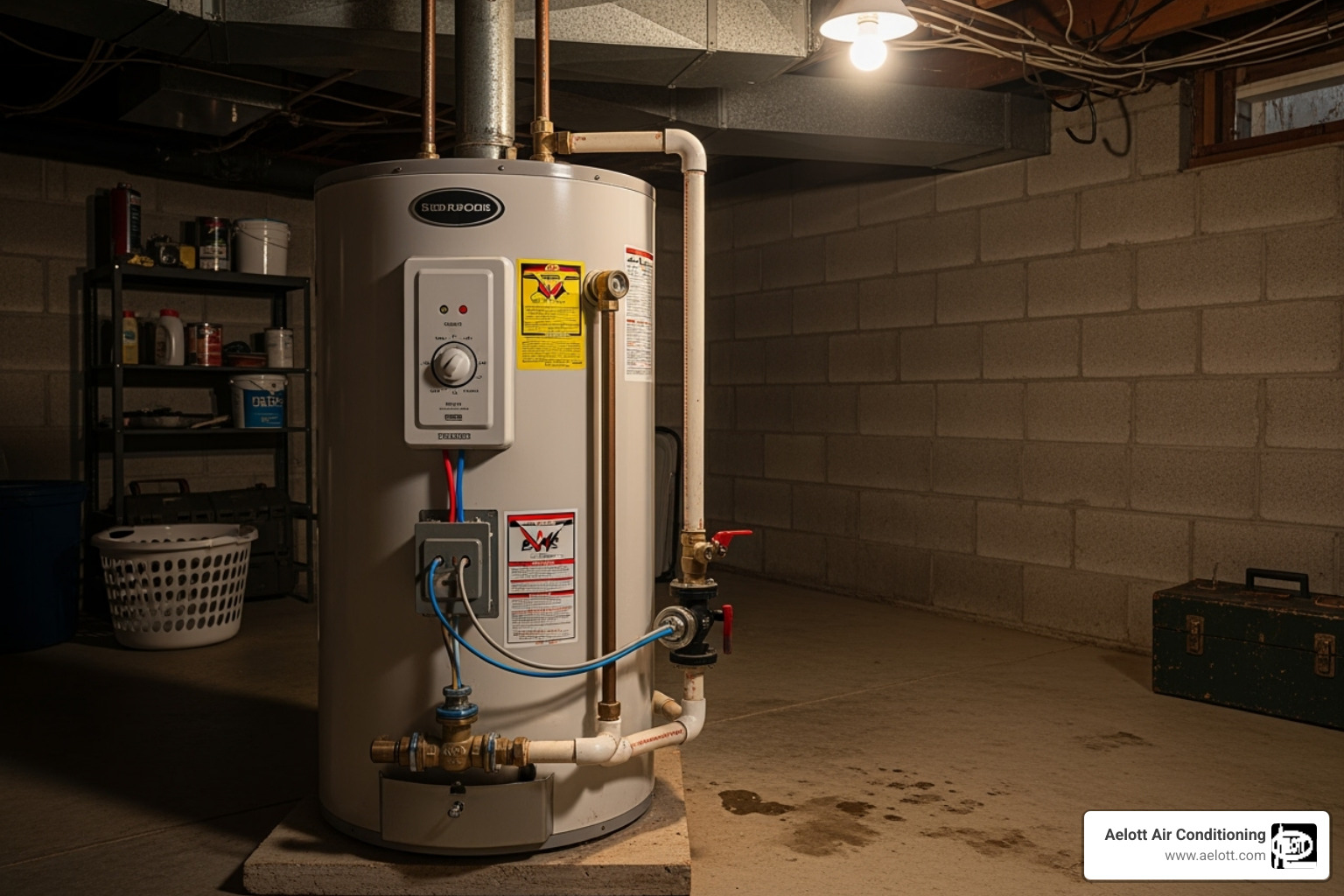
Why Understanding Electric Water Heater Problems Can Save You Money and Cold Showers
Electric water heater problems can quickly disrupt your daily routine. Whether you're facing no hot water, lukewarm temperatures, or strange noises, understanding the issue is the first step toward a fix.
The most common electric water heater problems include:
- No hot water - Usually caused by tripped breakers, failed heating elements, or faulty thermostats
- Not enough hot water - Often due to sediment buildup or a single failed heating element
- Water too hot - Typically indicates thermostat problems or incorrect temperature settings
- Strange noises - Usually caused by sediment buildup creating popping or rumbling sounds
- Leaks - Can range from simple valve issues to serious tank corrosion requiring replacement
- Rusty or smelly water - Often indicates anode rod failure or bacterial growth in the tank
The good news is that many issues are DIY-friendly. Electric models are simpler than gas heaters, with fewer parts and no pilot lights to worry about.
Electric water heaters are responsible for approximately 17% of a home's total energy consumption, making them one of your biggest energy users. When they're not working properly, you'll notice it in both your comfort and your utility bills.
In North County San Diego's climate, a reliable water heater isn't just about comfort - it's essential for daily life. From morning showers to dishwashing, we depend on hot water more than we realize.
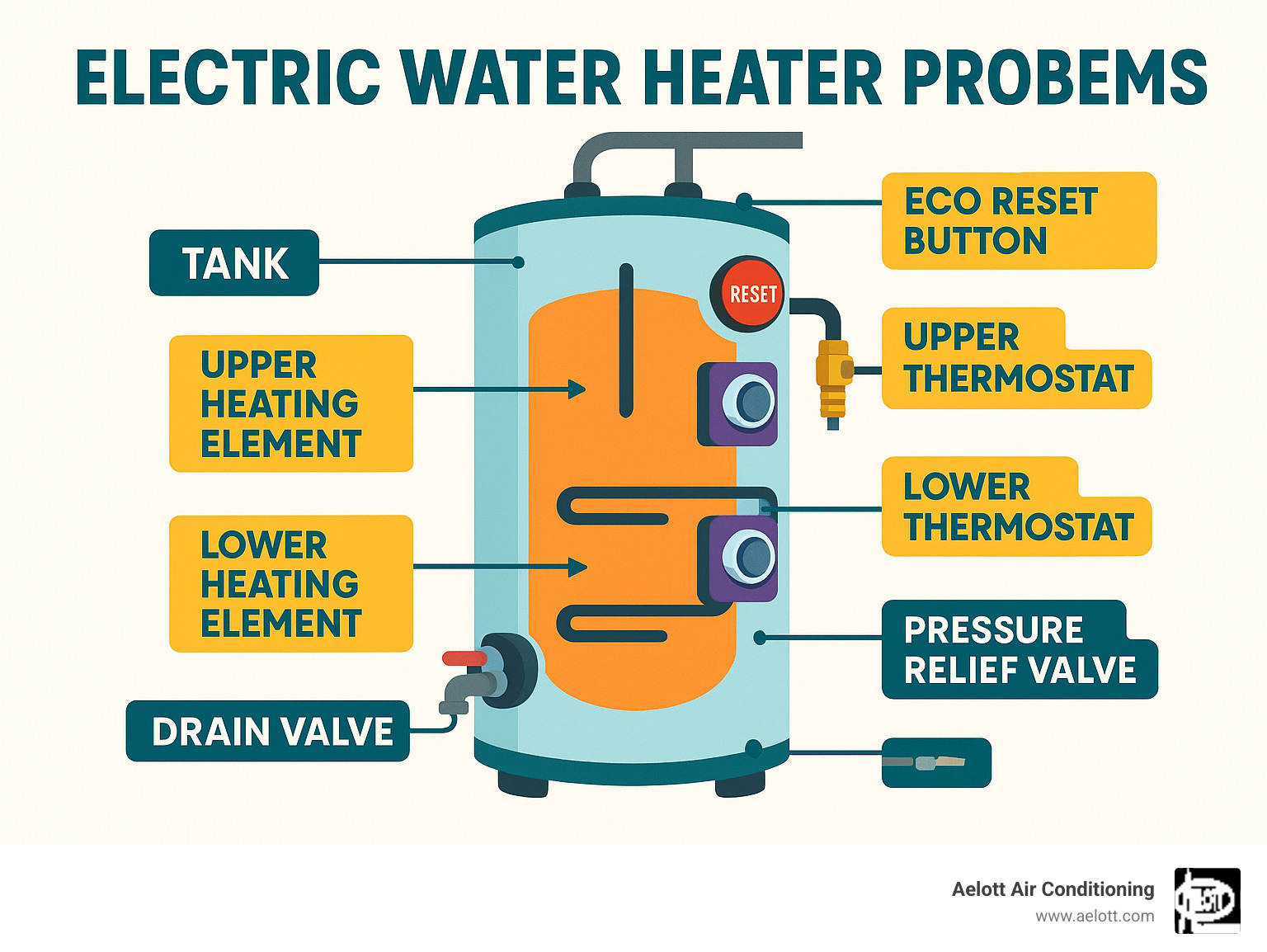
Safety First: Prepping for Your Water Heater Inspection
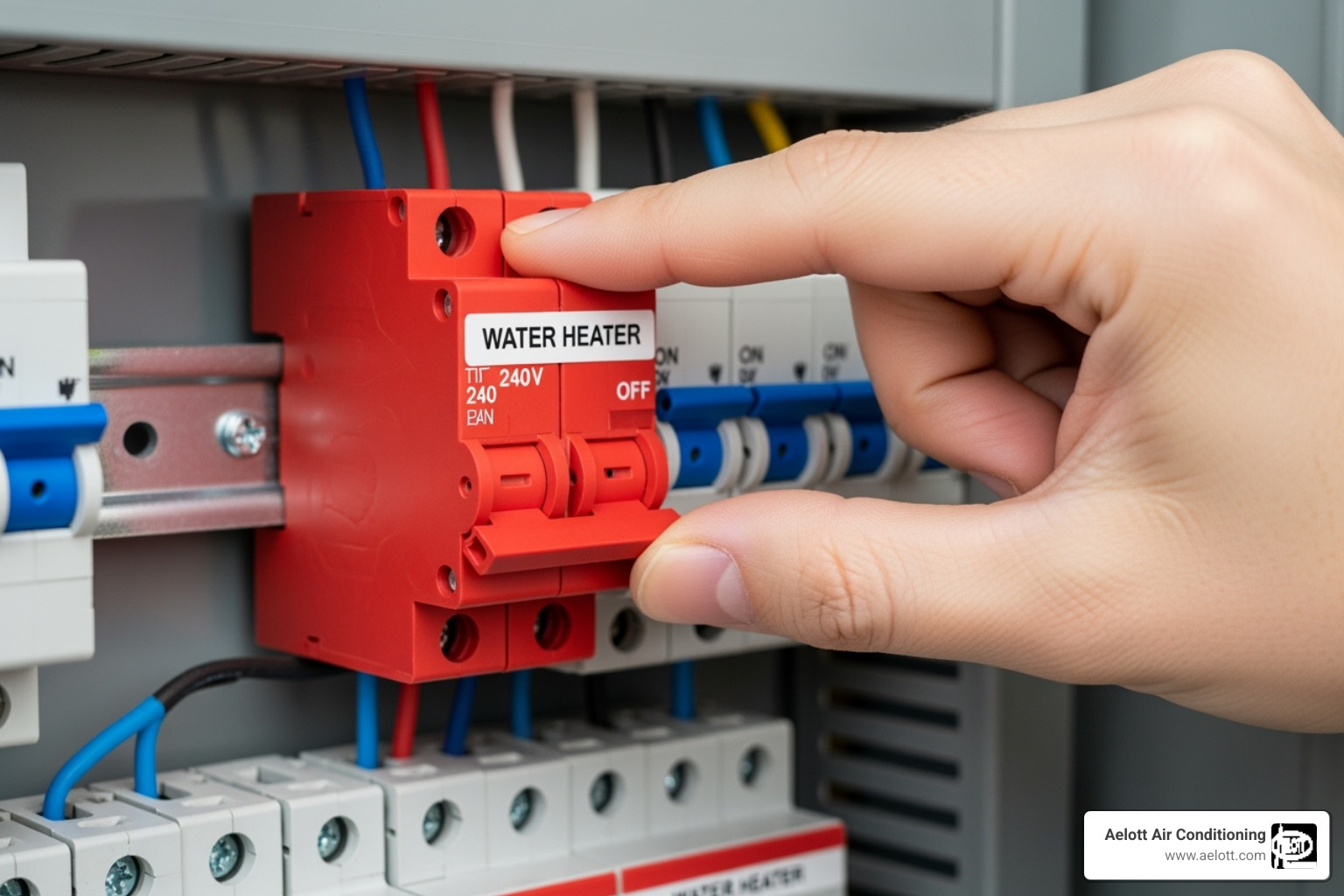
Before diagnosing electric water heater problems, safety is paramount. Water and electricity are a dangerous mix, so proper preparation is essential for your safety. This prep work is the difference between a successful DIY repair and a potential accident.
How to Safely Turn Off Power to Your Water Heater
Your first mission is to cut the power to your water heater completely. Head to your home's electrical panel, typically in the garage, basement, or a utility closet. Look for the circuit breaker labeled "Water Heater," "Hot Water Heater," or "HWT." Electric water heaters use a lot of juice, so you're looking for a double-pole 240-volt breaker - it looks like two switches connected together.
Flip that breaker firmly to the OFF position. You should hear a definitive click.
Now, you must verify the power is actually off. Breakers can fail, or you might have flipped the wrong one.
Your non-contact voltage tester is crucial here. These devices light up or beep if they detect current. After opening the access panels, wave the tester near the wiring. If there's no signal, you can proceed.
For double confirmation, use your multimeter set to AC voltage and test directly at the heating element terminals. A reading of zero volts means you're safe to proceed.
Here are the essential tools you'll need for troubleshooting your electric water heater safely:
- Multimeter for testing voltage and continuity
- Non-contact voltage tester for quick safety checks
- Screwdrivers (both Phillips and flathead)
- Insulated gloves for handling electrical components
- Safety glasses to protect from debris
- Flashlight or headlamp because water heater closets are surprisingly dark
Accessing the Internal Components
With the power confirmed off, you can look inside your water heater. Most electric models have two access panels (upper and lower) held in place by screws. Remove them with your screwdriver.
Behind the panels, you'll find fiberglass insulation and a plastic safety cover. Wear gloves and safety glasses, as fiberglass can be an irritant. Move the insulation aside to access the plastic cover.
Remove the plastic cover to see the heating elements, thermostats, and the ECO reset button (usually on the upper thermostat). These are the components we'll be testing.
The upper and lower sections work as a team - the upper element heats first, then signals the lower element to kick in. Understanding this sequence will help you diagnose which component might be causing your electric water heater problems.
A Step-by-Step Guide to Common Electric Water Heater Problems
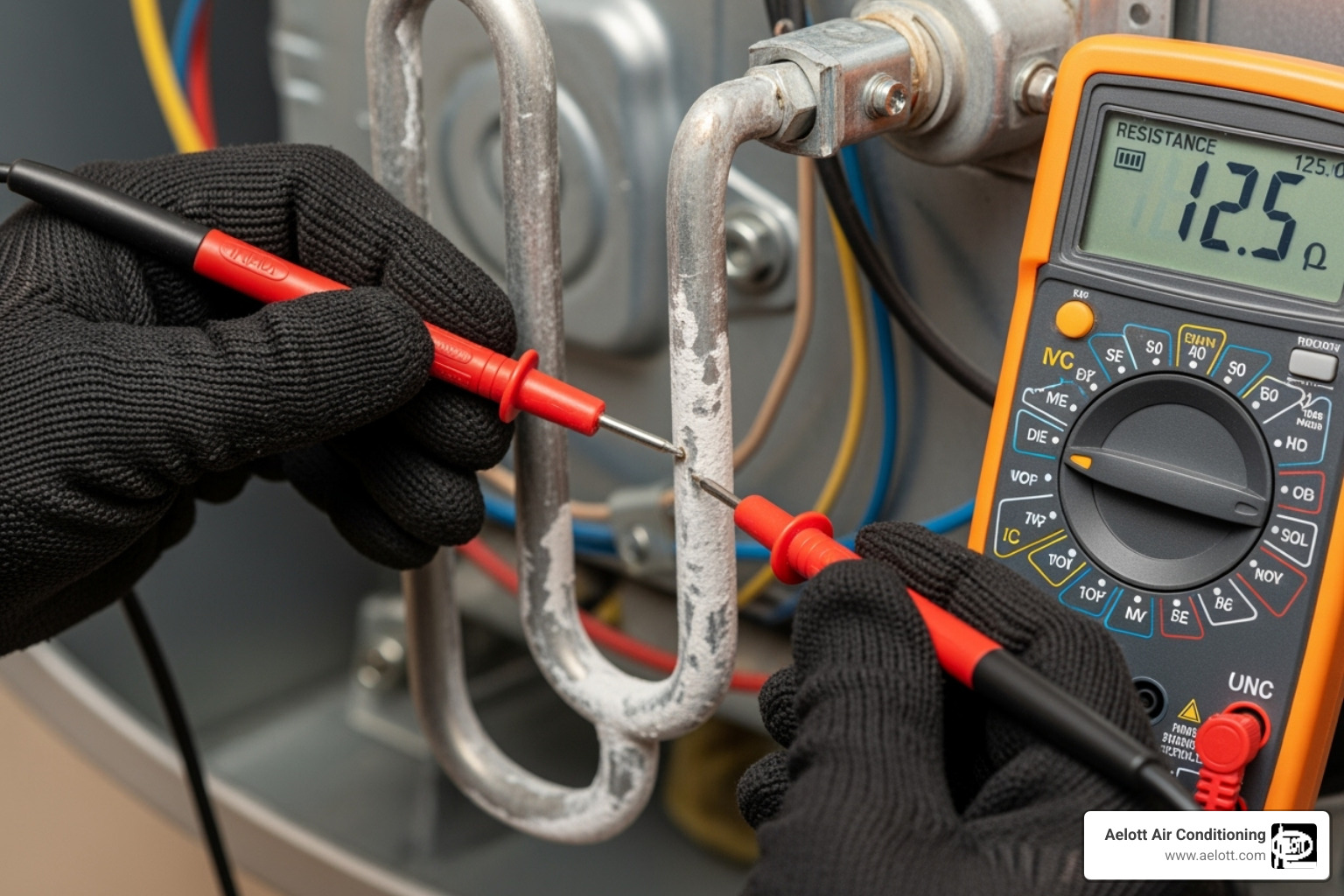
With safety covered, let's solve the most common electric water heater problems. Most issues have simple explanations, and this guide will help you find the culprit.
Diagnosing the Most Frequent Electric Water Heater Problems
If you have no hot water, the most common cause is a tripped circuit breaker. Head to your electrical panel and look for the water heater breaker. If it's flipped to "OFF" or in the middle, push it firmly to "OFF," then back to "ON." You should hear a solid click. Give your water heater about 30 minutes to heat up.
If the breaker keeps tripping, don't reset it again. This indicates a serious issue like a shorted heating element or faulty wiring that requires professional attention.
The second most common culprit is the E.C.O. button (Emergency Cut-Off). This red button on the upper thermostat is a safety device that trips when water temperatures get dangerously high (above 170°F), shutting down the unit to prevent scalding.
To reset the E.C.O., first make sure the power is off at the breaker. Remove the upper access panel and plastic cover, then look for the small red button. Press it firmly until you hear a click. Replace everything, turn the power back on, and you should be back in business.
If the E.C.O. keeps tripping, something is causing your water to overheat and needs investigation. For more tips on preventing these issues, check out our guide on heating maintenance.
How to Test Your Heating Elements
Your water heater has two heating elements. If one fails, you'll get lukewarm water; if both fail, you'll have no hot water. Testing them requires a multimeter. Remember – power must be OFF and verified before you start.
Start by removing both access panels and disconnecting the wires from each heating element's terminals. A quick photo with your phone before disconnecting can save you headaches later.
Set your multimeter to the ohms setting and touch the probes to each element's terminals. A working element will show a specific resistance reading. If your meter reads "OL" or infinity, the element is bad and needs replacement.
Here's what you're looking for: 3500W elements should read around 16 ohms, 4500W elements around 12-13 ohms, and 5500W elements around 10-11 ohms. Check the wattage printed on the element for its specification.
Next, check if the element is "grounded," which is dangerous. Touch one probe to an element terminal and the other to any unpainted metal part of the tank. A healthy element should show no continuity (reading "OL"). Any resistance reading means the element is shorted and must be replaced immediately.
Checking the Thermostats for Faults
Thermostats are the brains of the operation, telling the heating elements when to turn on and off. Signs of a faulty thermostat include scalding hot water despite a reasonable setting, or lukewarm water when you need it hot.
Many homeowners don't realize the upper thermostat controls both elements, directing power to each one in sequence. If it fails, the entire system can malfunction.
Testing thermostats requires the same multimeter skills. With power off and wires disconnected, check for continuity between the incoming and outgoing terminals. A working thermostat should show continuity when it's supposed to be "on."
Temperature settings matter. We recommend keeping your water heater at 120°F. This is hot enough for most needs without posing a scalding risk or wasting energy. If your water isn't hot enough, try nudging the temperature up slightly, but avoid cranking it way up. Sometimes, an incorrect thermostat setting is the only electric water heater problem.
Advanced Electric Water Heater Problems: Leaks, Noises, and Smells
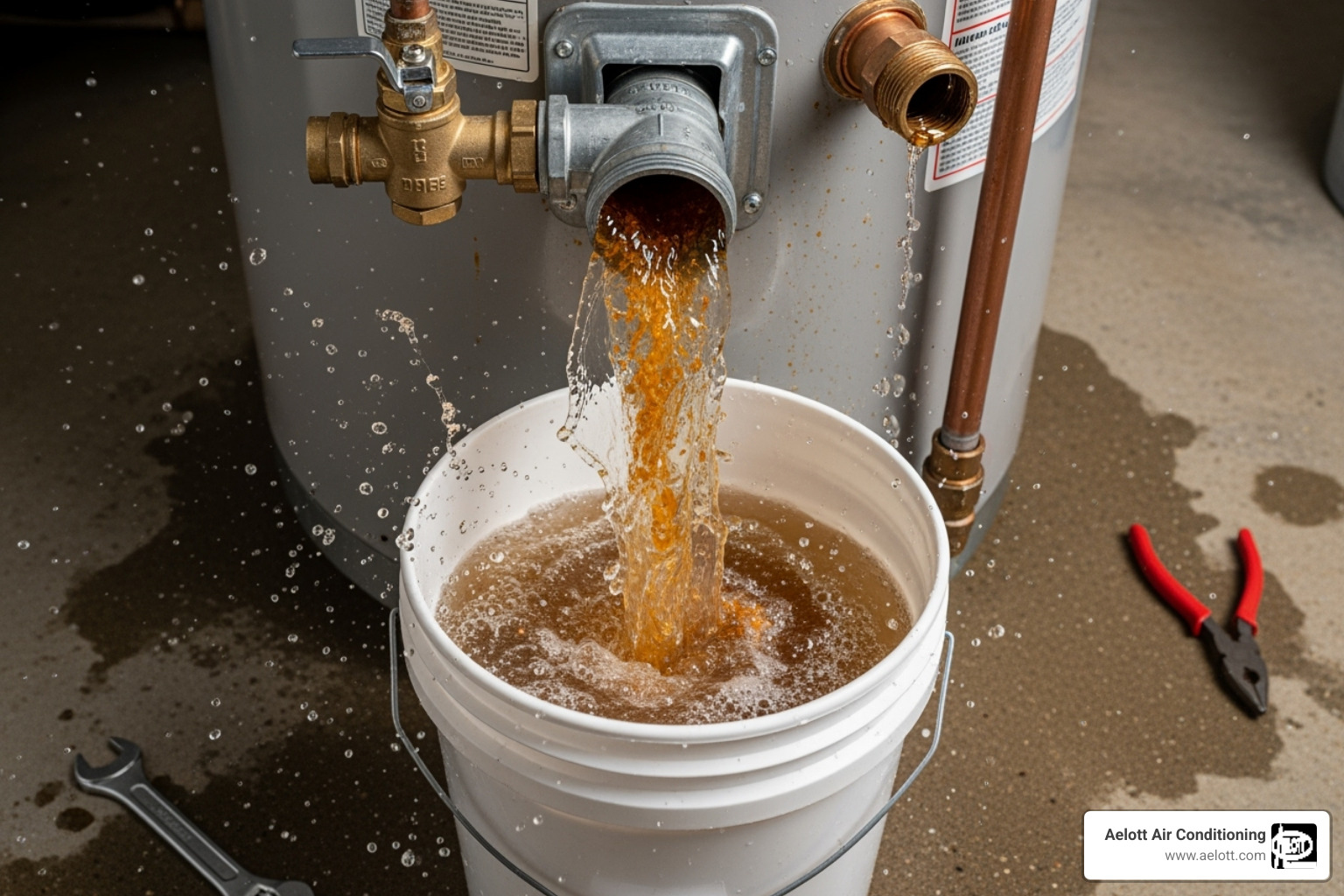
Identifying and Addressing Leaks
A leak near your water heater is a serious issue that can cause significant property damage. The location of the leak is key to diagnosing the problem.
Not all leaks are catastrophic. A drip from the pressure relief valve might mean high water pressure or a faulty valve. However, a constant discharge indicates dangerous pressure buildup, possibly from a malfunctioning thermostat.
The drain valve at the bottom is another common leak spot. Mineral deposits can prevent it from closing completely. Often, opening and closing the valve a few times can flush out debris and fix the drip.
Pipe connections where water enters and exits are usually easy fixes, often resolved by tightening connections or replacing worn seals.
Tank corrosion is the most serious leak source. If you see water pooling at the base of the unit or leaking from the tank walls, the tank has likely failed from internal corrosion. Unfortunately, a leaking tank cannot be repaired and must be replaced.
Watch for rusty water combined with leaks, as this signals advanced corrosion. While rusty water alone might just mean your anode rod needs replacement, paired with a tank leak, it confirms the water heater has reached the end of its life.
If you see signs of tank corrosion or can't find the leak's source, don't wait. Our team provides reliable heating repair in Escondido, CA, and we've helped countless homeowners with these challenges.
What's That Noise? Decoding Water Heater Sounds
Strange noises from your water heater indicate specific electric water heater problems that can often be fixed.
Popping and rumbling sounds are almost always caused by sediment buildup. Minerals settle at the bottom of the tank, and when the lower element heats water trapped beneath this layer, it boils and creates popping sounds. This sediment also costs you money by acting as an insulator, forcing heating elements to work harder, which increases energy bills and shortens the unit's life.
Hissing or sizzling usually means water is dripping onto a hot heating element or there's excessive scale on the element itself.
Knocking or banging can be caused by water hammer, which happens when water flow stops suddenly, causing pipes to knock.
The solution for most noise issues is flushing your tank annually. Turn off the power and cold water supply. Connect a garden hose to the drain valve and run it to a drain or outside. Open the drain valve and a hot water faucet to help it drain. Once the water runs clear, close the valves, refill the tank, and restore power.
Don't forget your anode rod; this sacrificial rod prevents tank corrosion, and a failing one can contribute to noise.
Dealing with Discolored or Smelly Water
Discolored or smelly hot water (when cold water is clear) points to problems inside your water heater.
Rusty or brown water typically means your anode rod has failed and your tank lining is starting to rust. Replacing the anode rod early can add years to your water heater's life.
A rotten egg smell is hydrogen sulfide gas, created when bacteria in the tank react with the anode rod. This is common with well water.
Fixing smelly water usually involves flushing the tank, replacing the standard anode rod with an aluminum-zinc alloy version, and sometimes disinfecting the tank. For detailed guidance on treating smelly water from bacteria, professional consultation is often the best long-term solution.
Low hot water pressure can also indicate sediment buildup restricting flow through your system.
The key with these advanced issues is recognizing when they move beyond simple DIY fixes. While annual flushing can prevent many problems, persistent odors or significant sediment often require professional diagnosis.
When to Put Down the Tools and Call a Professional
Look, we love empowering homeowners to tackle their own electric water heater problems. There's something satisfying about diagnosing an issue and fixing it yourself! But after six decades in the HVAC business serving Escondido and North County San Diego, we've learned that some situations are best left to the professionals.
Think of it this way – you wouldn't perform surgery on yourself, right? Some water heater issues fall into that same category.
A repeatedly tripping breaker is your water heater's way of screaming for help. If that circuit breaker keeps flipping off immediately after you reset it, or if it trips frequently, you're dealing with a serious electrical short or overload. This usually means a heating element has failed catastrophically or there's damaged wiring somewhere. This isn't just an inconvenience – it's a genuine fire hazard that needs immediate professional attention.
Major tank corrosion is another clear sign to call in the cavalry. Remember those leaks we talked about earlier? If water is seeping from the tank body itself, or if you're still getting rusty water even after replacing the anode rod, your tank has reached the end of its useful life. A corroded tank can't be patched up like a bicycle tire – it needs complete replacement.
Electrical wiring issues should make you step back immediately. If you find burnt wires, damaged connections, or anything that looks "off" with the electrical components, don't try to MacGyver a solution. Working with 240-volt electrical systems requires specialized knowledge and tools. One wrong move can result in serious injury or property damage.
Sometimes the problem isn't technical complexity – it's simply that the repair is beyond your comfort level. Maybe the troubleshooting steps feel overwhelming, or you're second-guessing yourself at every turn. That's completely normal! There's no shame in recognizing your limits. In fact, it shows good judgment.
Age matters too. If your electric water heater is pushing 10-15 years old and experiencing multiple problems, replacement often makes more financial sense than throwing good money after bad on repairs. An older unit that's having issues today will likely have more problems tomorrow.
Most importantly, your safety comes first. Professional technicians have years of training, specialized tools, and insurance coverage. We understand the risks and know how to work safely with both electricity and pressurized water systems. At Aelott Air Conditioning, we take this responsibility seriously – we're committed to Ensuring Community Safety with Proper Licensing and following all industry safety standards.
When you do need professional help, you want a team that's been around the block. Since 1963, we've seen every type of electric water heater problem imaginable, and we've developed efficient solutions that save you time and money. Sometimes the most cost-effective DIY decision is knowing when to call the experts.
Frequently Asked Questions about Electric Water Heater Issues
After decades of helping North County San Diego families with their electric water heater problems, we've heard just about every question you can imagine! Here are the ones that come up most often during our service calls.
What is the most common reason an electric water heater stops working?
In our experience, the most common culprits are a tripped circuit breaker, a faulty heating element, or a bad thermostat. When we roll up to a house and hear "we have no hot water," these three issues account for about 80% of the problems we encounter.
Here's the thing - always check that circuit breaker first! It sounds too simple, but you'd be amazed how often we arrive at a service call only to find the breaker has quietly tripped. Before you start taking apart access panels or testing components, take that quick walk to your electrical panel. It could save you a lot of time and effort.
If the breaker isn't the issue, then we're usually looking at heating elements or thermostats. These components work hard every day, heating water on demand, so it's natural they wear out over time. The good news is that with the troubleshooting steps we've covered in this guide, you can often identify which component has failed.
How long should an electric water heater last?
Most tank-style electric water heaters will give you 10-15 years of reliable service. That said, we've seen some units push 20 years with excellent maintenance, while others barely make it to 8 years due to hard water or neglect.
Your water quality plays a huge role here. If you live in an area with hard water (which is common in parts of San Diego County), the mineral buildup can be particularly tough on your system. Regular maintenance like annual tank flushing and checking the anode rod every few years can significantly extend your water heater's life.
We always tell our customers that replacing heating elements and thermostats when they fail can often buy you several more years from an older unit. It's usually much more cost-effective than a full replacement, especially if your tank is still in good condition.
Can I fix a leaking water heater myself?
This one really depends on where that leak is coming from, and honestly, it's one of the most important questions to get right because water damage can be expensive and extensive.
If you've got a small leak from a loose drain valve or pipe connection at the top of the unit, that's often something a handy homeowner can tackle. These are usually just loose fittings that need tightening or worn seals that need replacing. We've talked many customers through these fixes over the phone.
But here's where we draw the line: if water is leaking directly from the tank body itself, that's a whole different story. This usually means internal corrosion has eaten through the tank wall, or there's a crack in a weld. Unfortunately, there's no fixing this - the entire unit needs replacement.
A leak from the tank is actually an emergency situation. We've seen these small leaks turn into major floods in just a matter of hours. If you suspect the tank itself is leaking, turn off the water supply immediately and give us a call. Your homeowner's insurance will thank you for acting quickly!
Your Trusted Partner for Water Heater Solutions
Congratulations! You've now got the knowledge to tackle many common electric water heater problems with confidence. From the basics of safely shutting off power to testing heating elements and thermostats, you're equipped with the essential troubleshooting skills that can save you both money and those dreaded cold showers.
The key takeaways for successful DIY troubleshooting are always safety first – never skip turning off the power at the breaker and verifying it's off with your voltage tester. Most issues start with simple checks: tripped breakers, failed heating elements, and faulty thermostats are the usual suspects behind most electric water heater woes.
But here's the thing – knowing your limits is just as important as knowing how to use a multimeter. While we love empowering homeowners to handle basic maintenance and repairs, some situations absolutely require professional expertise. Repeatedly tripping breakers, major tank corrosion, electrical wiring issues, and complex repairs are all signs it's time to put down the tools and pick up the phone.
That's where we come in. At Aelott Air Conditioning, we've been solving electric water heater problems and keeping North County San Diego homes comfortable since 1963. Our decades of experience mean we've seen every possible water heater scenario – from the simple fixes to the head-scratchers that leave homeowners stumped.
What sets us apart? We believe in honest pricing and treating every customer like family. No surprise fees, no upselling tactics – just straightforward solutions backed by our 100% satisfaction guarantee. Whether you're in Escondido, Carmel Mountain, Del Mar, or anywhere throughout North County San Diego, we're your neighbors, and we're here when you need us most.
When professional help is needed – whether it's a tank replacement, complex electrical work, or simply peace of mind that the job is done right – our licensed technicians have the expertise and specialized tools to get your hot water flowing again safely and efficiently.
For reliable and expert heating services in Escondido, CA, contact our team today. Because life's too short for cold showers, and your comfort is our commitment.

Customer Testimonials
Go With Experience

HVAC Financing Available!
Get 0% Financing for 12 Months with Deferred Interest! Enjoy no payments and no interest on select plans.


Latest Blogs

.avif)
How to Run Your Furnace Efficiently: A Guide to Staying Warm This Winter







